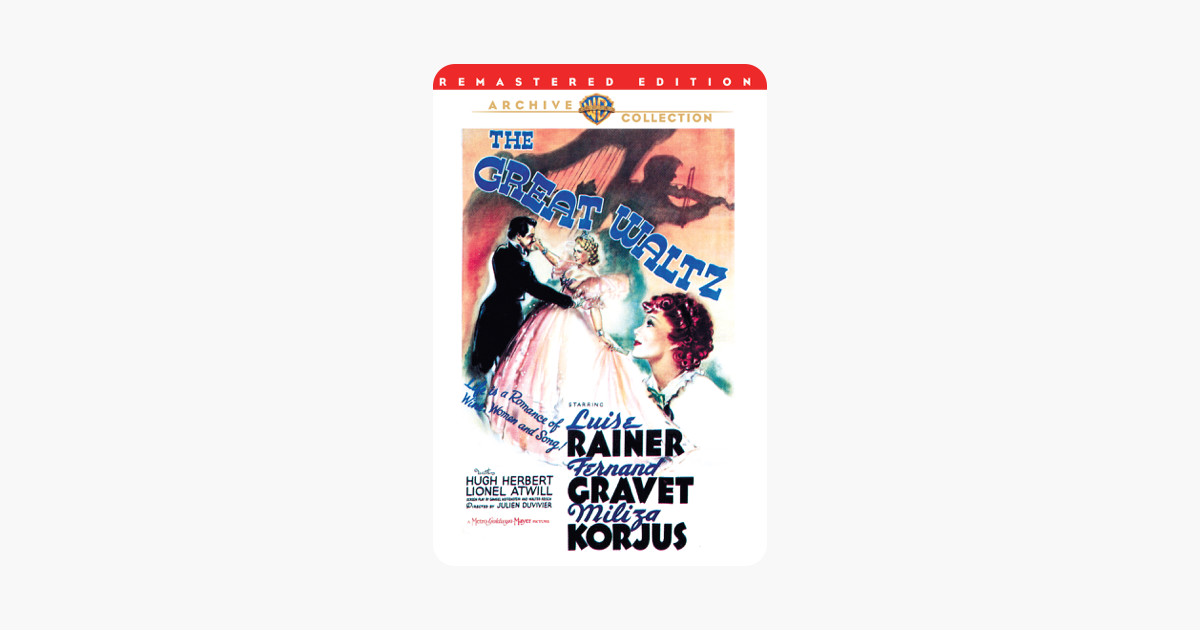The Great Waltz Mac OS
Based, very loosely, on the life of composer Johann Strauss II, the first Great Waltz was a successful stage musical, debuting on Broadway in 1934. Using Strauss’ music, the production had lyrics by Desmond Carter. MGM announced that they were planning a film version of Strauss’ life as early as 1935, with Nelson Eddy in the lead role. After much consideration they finally admitted that the project was on hold until a suitable operatic lead could be found to play opposite their leading man. By the time filming began in May 1938 a new book and lyrics had been commissioned by Oscar Hammerstein II, Fernand Gravet had replaced Eddy and Miliza Korjus had been ‘discovered.’ The film was released on 4th November 1938 and was a box office hit, receiving three Oscar nominations: Editing, Best Supporting Actress (Miliza Korjus) and Cinematography (Joseph Ruttenberg, who was the film’s only winner). The film was a popular re-issue, revisiting cinemas in the US in 1947, and across Europe in the late 1940s and early 1950s. In 1943 the BBC broadcast a radio adaptation by Harry Alan Towers, which included “the voices of the original stars” using archive material from the film. It was a particular success in Australia where it played in Sydney and Melbourne for two years upon its original release. A classic musical romance the film is gorgeous to look at with sumptuous set and costume design perfectly blended with the music of Strauss (adapted by Dimitri Tiomkin) and the new musical numbers. That the film takes huge liberties with the truth is a shame, but MGM weren’t going to let historical accuracy get in the way of a good old-fashioned romp in the Vienna woods.
Click Here: - The Great Waltz (1972) Full Movie Watch Online Related search: 07 zglos sie (1976–1987) Full Movie Watch Online. The Great Waltz (1938). Biographical film based loosely on the life of, Johann Strauss II. Cast: Luise Rainer, Fernand Gravet and Miliza Korjus. It was the only starring role for Korjus, who was a famous opera soprano and played one in the film. Joseph Ruttenberg won the Academy Award for Best Cinematography.
Strauss was born into a musical family in Vienna in 1825, and followed in his father’s footsteps as a composer of dance music and operettas, despite Strauss Sr’s wish that he become a banker. His two brothers, Josef and Edward, also made a name for themselves as composers, but neither were as successful. He is perhaps best known as ‘The Waltz King’ and is regarded as being largely responsible for the popularty of that particular dance throughout Austria in the 19th century. In the film, Luise plays the entirely fictitious Poldi Vogelhuber, Strauss’ wife; in fact Strauss married three times, first to the singer Jetty Treffz (d. 1878), then to the actress Angelika Dittrich and finally to Adele Strauss (no relation). It isn’t clear why MGM deemed it neccessary to change these details as, within his three marriages there is enough material for a sensational biopic. Strauss died of pneumonia in June 1899, aged 73.
MGM’s take on his life differs somewhat from the actual events. Here, Strauss is a banker who is fired after being discovered composing a waltz whilst on duty. Not disheartened, he uses his free time to concentrate on music, with the backing of his sweetheart, Poldi, the daughter of a baker. One day, whilst visiting Poldi’s father’s bakery he is offered a chance to perform in an orchestra with Kienzl, one of the bakers, who suggests they should put a show together for a local café, Donnmayer’s. The orchestra aren’t received well by the café’s customers, but just as they are about to give up two stars of the Imperial Opera, Fritz Schiller and Carla Donner, arrive and request that the orchestra play for them. The café is soon packed and people start to dance in the streets (the way they do in musicals). Carla offers Strauss an invitation to a party hosted by Count Hohenfried where she controversially performs one of Strauss’ waltzes (they are considered rather working class by many of her opera friends) and she wins over the crowd, including the music publisher, Julius Hofbauer. But Strauss senses that neither the Count nor Carla have really taken him seriously as a composer and that he is being shown off like a new toy to amuse their friends. He leaves the party and determines to marry his sweetheart, Poldi, which he does so shortly afterwards. During the course of all these shenanigans a subplot is brewing; a revolution has been growing across the city and, coincidentally, one of Strauss’ marches becomes an anthem; it is during one such march that Strauss rescues Carla from a carriage surrounded by revolutionaries and they escape through the Vienna Woods (composing his famous Tales from the Vienna Woods waltz along the way). The revolution fails and Strauss decides he will leave Vienna with his wife, but he has grown closer to Carla and when he is commissioned to write an opera for her he stays and they fall further in love with each other. Poldi, who has remained silent about her husband’s love for Carla does not attend the opening. But the Count urges Poldi to go to the Opera House and stop the affair; she does so, but, upon seeing his triumph she offers to sacrifice her marriage as she cannot inspire him the way that Carla does. Carla, however, cannot accept this and leaves without Strauss. In the years to follow Strauss achieves worldwide fame and countless honours, with his wife by his side.
The Great Waltz looks and sounds gorgeous, but is light on drama and common sense. It was a commercial success, although some critics were less than impressed with the liberties taken story-wise. One of the now infamous scenes shows Strauss composing his famous waltz Tales from the Vienna Woods – whilst riding in a carriage through said woods he is inspired by the movement and sounds and virtually composes the piece on the spot! Once again MGM looked to their European stars to bring the film to life, and it’s a testament to the influence of that continent’s culture at the time that the top three stars are all from across the Atlantic, along with the French director, Julien Duvivier. Luise was given top billing at the insistence of the producers, her name still enough to draw the crowds after her double Oscar triumph. In this film, however, her role is much smaller than previous outings, but she still maintains the heart of the film and reins in some of the excess with a measured and perfectly nuanced performance which stands out against the showy lead roles. The star of the film is undeniably the newcomer Miliza Korjus (advertising for the film carried the tagline ‘…pronounced ‘gorgeous’ ‘), a popular Polish opera singer who, much like Luise, was spotted performing in Europe and offered a contract with MGM. Her Oscar nomination is rare, one of the few singers so honoured by the Academy with an acting nod. In 1940, just before she was due to start filming her second picture, based on the life of the Hungarian folk-hero Sandor Rosza, she was badly injured in a car accident. Her recovery, and the impact of the Second World War, curtailed her film career. She recovered sufficiently enough to return to the stage in 1944 and continued to make concert appearances before retiring from singing in 1952. She died in California in August 1980. As Strauss, the Belgian actor Fernand Gravet (according to publicity ‘…pronounced ‘Gravy’ ‘) made his MGM debut. Already a star of some European and British films, he had come to America in the mid 1930s. He left soon afterwards, in 1939, and didn’t make another American film for 30 years, instead spending the war years and beyond in France. His singing voice was dubbed by Earl Covert and Ralph Leon, and the Russian virtuoso violinist Toscha Seidel was hired to dub Gravet’s playing scenes. He was a reliable leading man in European features and returned to the US in 1966 for How To Steal A Million. He died in Paris in 1971, aged 64.


Luise gives the film its heart and Poldi is the character with whom we sympathise throughout; once again she brings life to another stoical character who watches, helpless, as her husband is taken away from her. Her scene at the opera, where she goes backstage to congratulate Strauss and Carla Donner is almost a repeat of her famous ‘telephone scene’ in The Great Ziegfeld (1936) as she smiles through the heartache then rushes out into the street, tears streaming down her face. The film is masterfully directed by Julien Duvivier one of French cinema’s greatest directors, with a career stretching from silent cinema through to award-winning success at the Venice Film Festival in 1951. Some of the film was also shot by Austrian director Josef von Sternberg, and Victor Fleming directed supplementary scenes. Von Sternberg, in particular, was brought into the production late in the day to redirect parts of the film; in an interview with Bob Thomas in 1983 Luise says she “made the film twice” as “Duvivier was replaced because he was more interested in me than the other stars, and it had become the story of Mrs. Johann Strauss.”
Cast:
Luise Rainer as Poldi Vogelhuber
Fernand Gravet as Johann Strauss II
Miliza Korjus³ as Carla Donner
Hugh Herbert as Julius Hofbauer, Music Publisher
Lionel Atwill as Count Anton Hohenfried
Curt Bois as Kienzl
Leonid Kinskey as Dudelman
Al Shean as the Cellist
Minna Gombell as Mrs Hofbauer
George Houston as Fritz Schiller
Bert Roach as Vogelhuber
Herman Bing as Otto Dommayer
Alma Kruger as Mrs. Srauss
Henry Hull as Emperor Franz Josef
Sig Rugmann as Wertheimer, the Banker
Christian Rub as the Coachman
Uncredited roles: Ernie Alexander, Zita Baca, Eddie Conrad, Luke Cosgrave, Sidney D’Albrook, Loretta deLone, Joe de Stefani, George du Count, Jerry Fletcher, Bess Flowers, Christian J. Frank, Betty Fraunfelder, Ruth Fraunfelder, William Fraunfelder, Arno Frey, Boyd Gilbert, Wesley Giraud, Art Hamburger, Max Hoffman Jr., Has Joby, Edward Keane, Ben Lewis, Jane Loofbourrow, George Magrill, Albert Mahler, Anthony Marlowe, Frank Mayo, Mira McKinney, John Merton, Torben Meyer, Howard M. Mitchell, Sue Moore, Ferdinand Munier, Russ Powell, The Robert Mitchell Boys’ Choir, Bodil Rosing, Walter Sande, Ralph Sanford, Brent Sargent, Lester Sharpe, Larry Steers, Gertrude Sutton, Phillip Terry, Ellinor Venderveer, Roland Varno, Paul Weigel, Henry Zynda
Crew:
Directed by Julien Duvivier¹
Story by Gottfried Reinhardt
Screen Play by Samuel Hoffenstein and Walter Reisch with uncredited contributions from Vicki Baum
Produced by Bernard H. Hyman (uncredited)
Assistant Director: Robert A. Golden (uncredited)
Second Unit Director: Robert Rosson (uncredited)
Cinematography by Joseph Ruttenberg² Edited by Tom Held³
Art Direction by Cedric Gibbons
Associates: Paul Groesse and Edwin B. Willis
Gowns by Adrian
Miss Korjus’ hair stylist: Sydney Guilaroff
Sound Recording Director: Douglas Shearer
Dances and ensembles directed by Albertina Rasch
Musical Director: Arthur Gutmann
Orchestration by Paul Marquart
Strauss’ music adapted and aranged by Dimitri Tiomkin
Dialogue directed by Eric North (uncredited)
Vocal stand-in for Miss Korjus: Alice Mock (uncredited)
Violin stand-in for Mr. Gravet: Toscha Seidel (uncredited)
Voice doubles for Mr. Gravet: Earl Covent and Ralph Leon (uncredited)
The Great Waltz Mac Os Download
¹some scenes and retakes attributed to Victor Fleming and Joseph von Sternberg
²Academy Award winner
³Academy Award nomination
Further reading:
Remembering Miliza Korjus and MGM’s “The Great Waltz” (1938)by Sean Martinfield
The Great Waltz Mac Os X
Gallery: